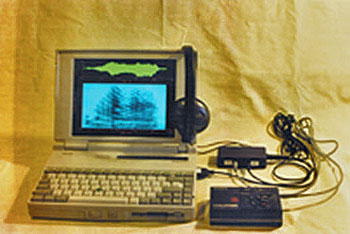|
Engineering Design was founded in 1980 to address problems in instrumentation and measurement, physical acoustics, and digital signal analysis.
Since 1984, Engineering Design has been the developer of the SIGNAL family of sound analysis software. Applications include sound and vibration measurement, sound modeling and synthesis, animal behavior, perceptual cognition, human auditory testing, and neurophysiological experimentation.
Company projects include:
 a multi-channel telemetry-based system to record and acoustically track bowhead whales on the arctic coast of Alaska a multi-channel telemetry-based system to record and acoustically track bowhead whales on the arctic coast of Alaska
 an 8-channel real-time system to monitor and detect free-ranging elephant vocalizations and discriminate vocalizations from noise an 8-channel real-time system to monitor and detect free-ranging elephant vocalizations and discriminate vocalizations from noise
 a two-channel ultrasonic recording and playback system with program-controlled attenuation and a total playback bandwidth of 1 MHz, for binaural stimulus presentation to bats a two-channel ultrasonic recording and playback system with program-controlled attenuation and a total playback bandwidth of 1 MHz, for binaural stimulus presentation to bats
 a closed-loop ultrasonic hardware system to return a bat signal in real-time with variable delay and frequency shift (accurate to 1 Hz out of 90,000 Hz) to simulate Doppler-shift frequency variation in the return echolocation signal, in order to study Doppler-shift compensation in the bat's neural system. a closed-loop ultrasonic hardware system to return a bat signal in real-time with variable delay and frequency shift (accurate to 1 Hz out of 90,000 Hz) to simulate Doppler-shift frequency variation in the return echolocation signal, in order to study Doppler-shift compensation in the bat's neural system.
 a hardware and software system for digitizing, archiving, testing and monitoring the long-term quality of the library of 27,000 animal sounds at The Ohio State University a hardware and software system for digitizing, archiving, testing and monitoring the long-term quality of the library of 27,000 animal sounds at The Ohio State University
 a 64-channel data acquisition and closed-loop control system to stimulate and record the dynamic failure of a concrete wall under earthquake-level stress produced by a 330,000-pound mechanical ram a 64-channel data acquisition and closed-loop control system to stimulate and record the dynamic failure of a concrete wall under earthquake-level stress produced by a 330,000-pound mechanical ram
 a data acquisition and analysis system to measure the ground-borne transmission of subway train vibration for the Boston subway system a data acquisition and analysis system to measure the ground-borne transmission of subway train vibration for the Boston subway system
 a low-noise (-127 dBV), high-gain (100 dB) differential microphone and preamplifier system to record the acoustics of drosophila (fruit fly) wing beats a low-noise (-127 dBV), high-gain (100 dB) differential microphone and preamplifier system to record the acoustics of drosophila (fruit fly) wing beats
 an automated analysis and classification system for the USDA, capable of recognizing and measuring eating events in free-grazing cattle from a continuous acoustic data stream. The goal is to estimate forage intake, model grazing efficiency and weight gain, and assess the economic viability of free-grazing livestock an automated analysis and classification system for the USDA, capable of recognizing and measuring eating events in free-grazing cattle from a continuous acoustic data stream. The goal is to estimate forage intake, model grazing efficiency and weight gain, and assess the economic viability of free-grazing livestock
 low-noise, high-precision electronic instrumentation for studio recording, field measurement, and laboratory experiments low-noise, high-precision electronic instrumentation for studio recording, field measurement, and laboratory experiments
|  a multi-channel telemetry-based system to record and acoustically track bowhead whales on the arctic coast of Alaska
a multi-channel telemetry-based system to record and acoustically track bowhead whales on the arctic coast of Alaska






